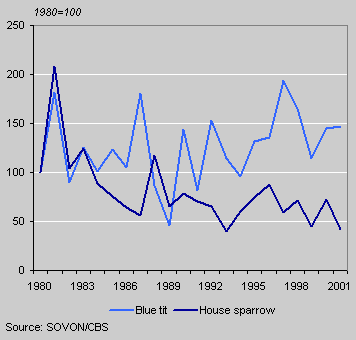House sparrow population naerly halved since 1980

The number of house sparrows in the Netherlands has nearly halved in the last twenty years.
Little wasteland and urban redevelopment
The reduction in areas of wasteland overgrown with weeds is one of the causes of the declining sparrow population. Such areas attract many insects which house sparrows need to feed their young. In inner city areas, in particular, there is little wasteland. Urban redevelopment schemes have resulted in larger distances between the inner city and these grounds on the edge of the towns and cities.
Renovation projects may also play a part: it is more difficult for sparrows to build nests in new types of roofs. New housing estates, too, often offer fewer suitable nesting places for sparrows.
House sparrows and blue tits in towns and cities (1980=100)

Diminishing food supply
Air pollution and the use of chemical pesticides in agriculture have also had a negative effect on the sparrow population, as these reduce the number of insects they need to feed their young. As kitchen and garden waste is thrown into closed containers in many cities, this also means less food for sparrows. And lastly, many house sparrows are caught by domestic cats and sparrow hawks.
More birds in urban parks
More and more birds live in older town and city parks, though. One species that is doing very well in the urban environment is the blue tit. One of the reasons for this is that trees in urban wooded areas are now more mature and thus provide more nesting opportunities.
Lodewijk van Duuren